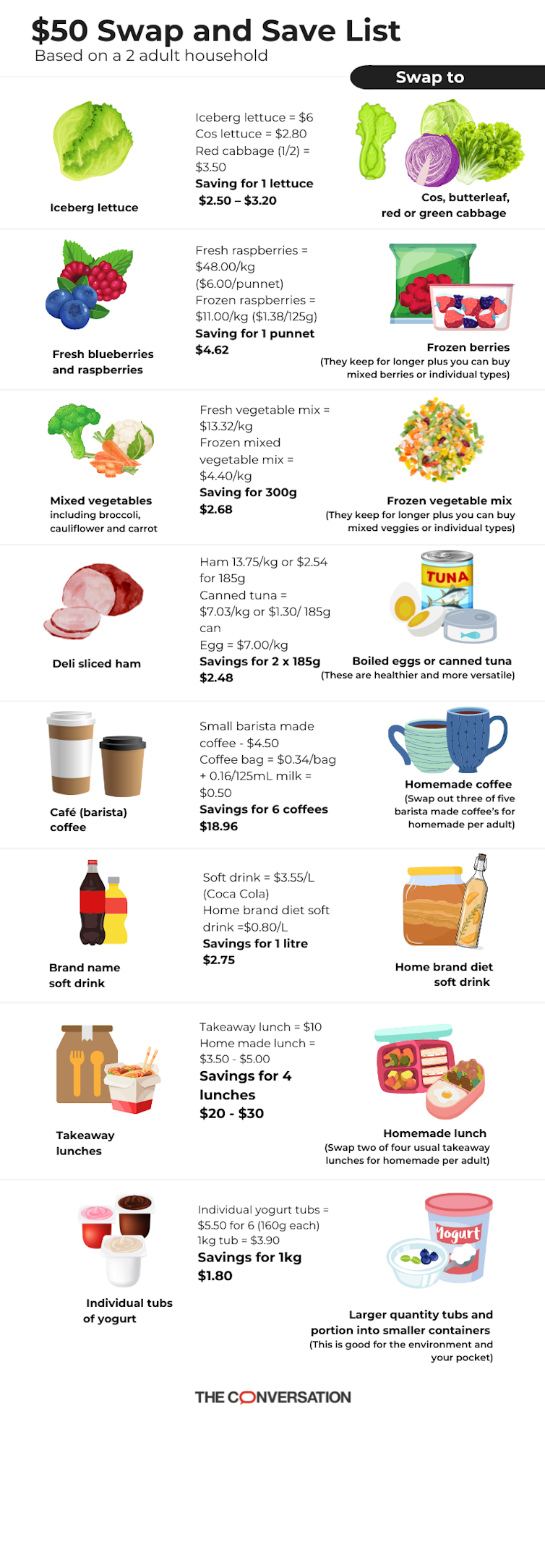
Grocery prices have taken a hike upwards for a host of reasons, including the rising costs of petrol, fertiliser and labour.
You could “shop around” for cheaper groceries, but that would cost you more in fuel or travel, not to mention time.
Research shows a healthy diet costs low-income households 20 to 30% of their disposable income. But a healthy diet remains cheaper than one dominated by highly processed foods and drinks.
Cutting your grocery bill takes planning and flexibility – and knowing your budget.
Read more: Yes, $5 for lettuce is too much. Government should act to stem the rising cost of healthy eating
So how do you do it?
Start by checking which vegetables and fruits are in season, and find recipes that include these.
Swap some fresh veggies and fruit with canned and frozen varieties, and substitute very expensive items for cheaper alternatives.
Have a meat-free meal at least once a week.
Read more: Health Check: five must-have foods for your shopping trolley
Next, create a grocery list. This helps save money by reducing in-store impulse buys. Look at what you already have in the pantry, fridge and freezer, and only buy what you need. This will reduce food waste.
Check online catalogues for specials before heading to the shops. Once in store, compare prices and choose brands that are cheaper. This makes nutritious meals more affordable.
How much do households spend on groceries?
A 2021 survey found the average supermarket grocery bill was A$98 per week for a single person, $145 for two, $168 for three, $187 for four and $255 for five or more people.
An older survey from 2016 found the average household (2.6 people) spent $269 per week across all food ($237) and alcohol ($32) purchases, both at the supermarket and other outlets.
About half the money was spent was on “discretionary” items such as meals out or fast food ($80), with $20 spent on lollies, chocolate, savoury snacks and potato crisps, and $10 on cakes, biscuits and puddings. At the supermarket, $26 was spent a week on fruit and vegetables.

A 2019 survey found the average person spent $300 a week for all food and drinks. This included groceries ($135), eating out ($52), alcohol ($31), take-aways ($22), barista coffee/tea ($13), food delivery services ($12), supplements ($12) and health foods ($11).
These surveys show it’s common to spend more on foods and drinks consumed away from home than on groceries and more on unhealthy items than healthy ones.
What about saving $50?

5 tips to help you save
Putting all this together, here are five key tips to keep in mind when planning food for your household:
1) Have a food budget
Total food budget dollars will be influenced by how many people you need to feed, their age and your household income. A rough rule of thumb is it shouldn’t cost more than one-third of your total household disposable income.
Allocate target amounts in your budget for both core, nutritious foods and discretionary foods and drinks (softdrinks, chips, biscuits, cakes, lollies, pies, pastries and deli meats) and on foods away from home (coffees, fast food, pubs, clubs, bottle shops and restaurants).
2) Make a weekly plan for breakfast, lunch, dinner and snacks
Write a matching grocery list. Check the pantry, fridge and freezer to see what you already have or whether any ingredients can be swapped to save a purchase.
3. Pack your lunch
Buy a lunch box and pack it the night before. Put it in the fridge so you can grab and go in the morning. For ideas, see our $5 make-at-home lunches.
If your mornings are too busy, pack in breakfast foods too.
4. Cook more meals at home
Cooking more meals at home might include cheaper and healthier versions of some of your take-out favourites such as pizza and burgers.
A study from the United States found those who cooked more at home spent half the amount of money on food eaten away-from-home than those who cooked infrequently. They also spent 17% less on food overall.
Interestingly, both groups spent the same on groceries suggesting that infrequent home cookers either wasted more food, ate more, or both.
Read more: Want to be happier, healthier, save money? It's time to get cooking
5. Cook double batches
Cook greater quantities of meals like curries, soups and casseroles, and either freeze them or have the same meal twice.
For those needing to shop on a significantly restricted budget, we’ve developed a $60 a week meal plan on our No Money No Time website. This free resource contains a meal plan with inexpensive recipes, designed to meet key nutrients needed for health.
If you need help getting food right now, try the Ask Izzy website. By submitting your postcode, it shows support services, such as free meals, near you.
The authors acknowledge the assistance of Hannah McCormick and Ilyse Jones from the No Money No Time Project team in preparing this article.
Clare Collins is a Laureate Professor in Nutrition and Dietetics at the University of Newcastle, NSW and a Hunter Medical Research Institute (HMRI) affiliated researcher. She is a National Health and Medical Research Council (NHMRC) Leadership Fellow and has received research grants from NHMRC, ARC, MRFF, HMRI, Diabetes Australia, Heart Foundation, Bill and Melinda Gates Foundation, nib foundation, Rijk Zwaan Australia, WA Dept. Health, Meat and Livestock Australia, and Greater Charitable Foundation. She has consulted to SHINE Australia, Novo Nordisk, Quality Bakers, the Sax Institute, Dietitians Australia and the ABC. She was a team member conducting systematic reviews to inform the 2013 Australian Dietary Guidelines update and the Heart Foundation evidence reviews on meat and dietary patterns.
Megan Whatnall is affiliated with the University of Newcastle, NSW, and Hunter Medical Research Institute. She has received research grants from Hunter Medical Research Institute, The National Heart Foundation of Australia, and nib foundation.
* This article was originally published at The Conversation
PUBLISH WITH US!
The Washington Gazette works at our discretion with businesses, non-profits, and other organizations. We do not work with socialists, crony capitalists, or disinformation groups. Click the green button below to view our services!
HELP STOP THE SPREAD OF FAKE NEWS!
SHARE our articles and like our Facebook page and follow us on Twitter!



0 Comments